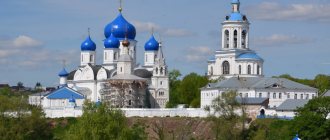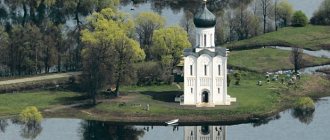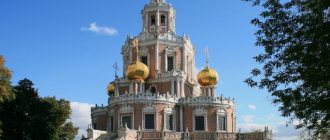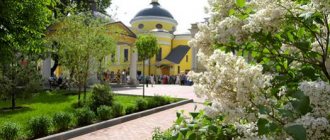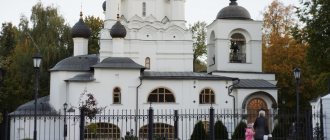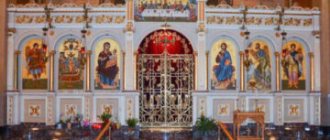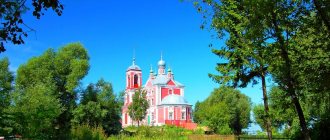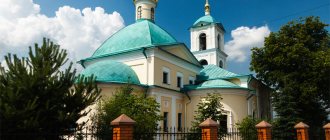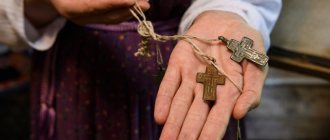October 14 is the Feast of the Intercession of the Virgin Mary. One of the masterpieces of ancient Russian architecture, perfectly preserved to this day, is directly connected with it. This is the Church of the Intercession on the Nerl not far from Bogolyubov.
The temple is considered the first architectural monument of Ancient Rus', which was dedicated to the Feast of the Intercession of the Blessed Virgin Mary.
Even if you have never been to Vladimir or Bogolyubovo, you have probably seen the church in photographs. The image of the temple has always been included in all school textbooks on the history of Ancient Rus'. I’m telling you this as a history teacher with 15 years of experience!
We pronounce it correctly
How to correctly pronounce the name of this amazing ancient Russian temple? Let us remember once and for all: Pokrov A on Nerl I.
The outstanding Soviet historian, archaeologist and art critic, our fellow countryman Nikolai Nikolayevich Voronin . From his pen came a lot of research on the monuments of ancient Russian architecture.
I like N.N. Voronin’s book “Vladimir. Bogolyubovo. Suzdal. Yuryev-Polsky (M., Art, 1967) " . It is read mainly by art experts and historians. But this study talks so figuratively about the Church of the Intercession on the Nerl that I decided to quote the most striking fragments in the essay. I have highlighted the most important points in these quotes in bold.
Click on the photos and they will open in larger sizes
- When and why was the church built
- Temple location
- Architectural features
- Sculptures on facades
- Pages of history
- Road to the temple
A unique fragment of ancient Rus'
The Church of the Intercession on the Nerl was built by Prince Andrei Bogolyubsky, with whose reign the heyday of the Vladimir-Suzdal principality is associated. During the same period (1157 - 1174) stone buildings were built in the principality, some of which were destroyed. The exact year of construction of the Church of the Intercession on the Nerl has not yet been established. Scientists have several versions.
Church of the Intercession on the Nerl: winter landscape
The beauty of the natural world around
The Nerl and Klyazma rivers flow next to the Church of the Intercession on the Nerl. Behind the temple there is a small pond, which becomes shallow in the summer and fills with water in the spring. It is from the side of this reservoir that the most picturesque view of the architectural monument opens.
Bogolyubovsky meadow near the church
Interesting fact: more than 290 plant species were discovered in the protected meadow near the church. 4 of them are listed in the Red Book of the Vladimir region. Sometimes white-tailed eagles, birds of prey that belong to the hawk family, land near the temple.
The total area of untouched territory near the chapel is 76.5 hectares. The flat, table-like terrain next to a quiet, flat river creates a feeling of calm and peace of mind. The church, which rises on a small hillock, resembles a white-skinned maiden, and the trees surrounding her make up the beauty's wreath and decorations.
Church of the Intercession on the Nerl: history of construction
The first version is that the temple was built in 1165 to commemorate the death of Andrei Bogolyubsky’s son, Prince Izyaslav. Thus, this is a memorial monument. The second - the church was erected in 1158 simultaneously with the construction of the church in honor of the Mother of God. The second church, dedicated to the Nativity of the Blessed Virgin Mary, is located on the territory of the Bogolyubsky Monastery, on the site of the former palace-castle of Prince Andrei.
Both versions are confirmed by different chronicle data. Therefore, the scientific community has not given preference to any of them to date.
The builders of the temple were apparently masons sent to Andrei Bogolyubsky by Frederick Barbarossa, Holy Roman Emperor. There is an assumption, based on indirect evidence, that before the start of his reign, Andrei Bogolyubsky participated in one of the crusades under the leadership of Barbarossa. It was there that their friendship began. This version is not very common. Most researchers believe that the monarchs did not know each other personally, but actively communicated through ambassadors and by correspondence.
Some researchers find indirect confirmation of the assumption about the European builders of the temple. For example, it is a well-known fact that there were few construction teams of masons in Europe in the Middle Ages. Therefore, they actively moved from country to country, looking for suitable orders. The hypothesis about European builders is also justified by the Romanesque style of the Church of the Intercession on the Nerl. The bas-reliefs on the façade, depicting King David, lions, doves, women’s masks and other decorative images, also correspond to this style.
Why in honor of the Feast of the Intercession of the Mother of God?
This is the first known
There is a temple in the world dedicated to this holiday. We cannot say that there were no Churches of the Intercession before, but science knows nothing about them.
Let us recall that the Feast of the Protection of the Mother of God was established in memory of the appearance of the Mother of God to the holy fool Andrew in the Blachernae Church of Constantinople during the all-night vigil. Moreover, it is believed that at that moment the city was under siege, and after a miraculous phenomenon the enemies retreated. This was in the 10th century. Why the holiday arose only 200 years later is a mystery. Although it is believed that it could have arisen earlier - in Byzantium, it was not so popular among other Mother of God holidays. From Byzantium he migrated to Kyiv, and from there he came to the Vladimir lands.
Andrei Bogolyubsky was sensitive to the veneration of the Mother of God, and almost all of the churches that he built and are now known are dedicated specifically to the Most Holy Lady.
Whether this was really something personal for the prince, or whether the special veneration of the Mother of God in Constantinople played a role is difficult to say now.
But the temple erected under Andrei Bogolyubsky turned out to be not only the first dedicated to the Intercession, but also the only one for the next 200 years.
Churches of the Intercession began to appear en masse only in the 14th century.
Why was the temple built here?
The location for the construction of the temple was not chosen by chance. Despite the proximity of rivers and spring floods, the church and the monastery around it were built precisely on the spout of the Klyazma and Nerl in the lowland, on a water meadow. Several theories explain the reasons for choosing a site for construction.
The first suggests that the Church of the Intercession on the Nerl was conceived as a ceremonial princely church not far from the residence of Andrei Bogolyubsky in the village of Bogolyubovo. Sailing along the confluence of two rivers, traders and ambassadors should have seen the first building of the princely court - an elegant white-stone church that looked like a candle. But some researchers refutes this version. They believe that in those years the prince had no time for ceremonial churches. It was necessary to monitor the difficult internal political situation and the military danger from neighbors.
The second theory says that the Church of the Intercession on the Nerl was a monastery church, and the monastery was a real fortress capable of repelling the attacks of nomads. This version has no reliable confirmation or refutation. Most likely, the monastery arose later, after the death of Andrei Bogolyubsky. Scientists only know that there was a monastery here. But it ended its existence in the 18th century under Catherine II, simultaneously with many other Russian monasteries that failed to pay the taxes imposed on them. The church was almost dismantled due to its unprofitability for the local diocese. Indeed, due to the remoteness from the villages, there were almost no permanent parishioners in the temple. The masterpiece of world architecture was saved only by the fact that the abbot was unable to reach an agreement with the contractors due to lack of money for dismantling work.
How to get to Bogolyubovo.
The most convenient way to go to Bogolyubovo is from Vladimir. Excellent quality of the road surface, several lanes for traffic and a beautiful view from the window, this is what awaits you on the road. The most convenient way to get to Bogolyubovo is by city bus. Routes No. 103 and 152 run here from Vladimir. Their stopping points are located at Cathedral Square and at the Golden Gate. The village of Bogolyubovo is noticeable from afar. The landmark is the large monastery, which is located on the right side of the road. This is where the stop called Bogolyubovo Center is located. It is not difficult to find a train station in this place. You can reach it along the road going to the right behind the monastery. Those who prefer to travel by car should drive from Vladimir towards Nizhny Novgorod along the M7 (Volga) highway. Bogolyubovo is the first settlement after Vladimir. It is worth keeping in mind that the road in the village is very narrow, so there are few parking places to choose from. There is free parking at the very entrance to the monastery, but the number of spaces is limited.
Church architecture
To protect the church from spring floods and flooding, the builders had to create a man-made hill three meters high and an area of approximately 23 acres. The foundation of the temple goes under water deeper than 5 meters, which made it possible to withstand the rise of water. The Church of the Intercession on the Nerl belongs to the cross-domed type. The volume inside it is divided by four pillars supporting the roof into nine squares. Unfortunately, the original interior paintings of the temple have not been preserved. In 1877 they were knocked down during internal repair work.
On each side, the outer walls of the temple end with three zakomaras - semicircular ends of the wall elements. Along the entire perimeter there are arcature belts, consisting of small columns located at an average height. The walls of the church are decorated with reliefs. Thanks to a special architectural solution, the building appears taller than it actually is. This gives the structure a special harmony and elegance.
King David and the beasts: who and why is depicted on the walls of the temple?
Of the churches from the time of Andrei Bogolyubsky, it was Pokrovsky that preserved its façade decor almost in its original form.
It is quite simple, especially in comparison with the decor of later churches during the heyday of white stone architecture under Vsevolod the Big Nest. But in this simplicity one can discern considerable symbolism. Its main component is the bas-reliefs.
King David
On three facades at the top there is an image of the biblical King David
, which was often used in European architecture as a symbol of a wise and just ruler. King David is surrounded by lions.
Cultural significance of the temple
The Church of the Intercession on the Nerl is a UNESCO World Heritage Site, whose complex also includes Bogolyubovsky Meadow, on which the church stands. It is one of the few stone temples that have come down to us, preserved in Rus' from the time before the Mongol invasion (mid-13th century).
For the Orthodox Church, the Church of the Intercession on the Nerl has special significance. This is the first historically authentically known temple that was dedicated to the Feast of the Intercession of the Blessed Virgin Mary. This holiday was originally originally Byzantine and its coming to Rus' is paradoxical. The events in honor of which the holiday was created took place at the beginning of the 10th century. Then an attack was made on Constantinople. Residents of the city prayed in the central temple for the protection of Constantinople from enemies. Then the holy fool Andrew and his disciple Epiphanius had a vision of the Mother of God spreading her veil over the city. The next day the enemies retreated.
The paradoxical thing is that these troops were Russian, they were led by Prince Oleg the Prophet. All the more surprising is the coming of the holiday to Rus'. Despite the fact that the events of the holiday took place in the 10th century, they began to celebrate it only 200 years later. And two centuries later, when from Byzantium through Kyiv the holiday spread across the lands of Rus', and the Church of the Intercession on the Nerl was built.
How is the church decorated?
It is also worth mentioning that the church has incredibly beautiful architecture . Its walls are decorated with beautiful frescoes depicting King David seated on a throne, fearsome lions and griffins lie at his feet, and the whole picture is completed by doves hovering over the king’s head .
Also on the walls are depicted several faces of beautiful women - three faces that symbolically depict the Virgin Mary.
How is the church decorated?
The current state of the Church of the Intercession on the Nerl
Now the Church of the Intercession on the Nerl is somewhat different from the original version. As, indeed, is the landscape around it. Instead of the confluence of two rivers, there is a small lake in front of it. This is an oxbow that was formed when the Klyazma and Nerl rivers changed their course. The white stone galleries, which, as excavations show, approached the temple from three sides, were destroyed. The original frescoes were knocked down during later reconstructions and renovations of the interior decoration. But otherwise, the church has retained its recognizable features. There are many reconstructions of the original appearance of the temple, but none of them can definitely be called final.
Currently, the Church of the Intercession on the Nerl is a museum where excursions and services are regularly held. Almost every tourist who comes to Vladimir visits this masterpiece of Russian white-stone architecture. If you want to visit this unique place, choose the summer season. In spring, getting to the temple is much more difficult - river floods cover almost the entire area around. In winter and autumn, slush and dirt make traversing difficult.
Read us conveniently on social networks:
Tags: Intercession on the Nerl, Church of the Intercession on the Nerl, Church of the Intercession on the Nerl, Church of the Intercession on the Nerl where it is located, Church of the Intercession on the Nerl
What was found as a result of excavations in the twentieth century?
, archaeological excavations were organized in the area where the church is located . As a result of the work, remains of an ancient foundation were found in the perimeter of the church. During the research, it was found that once there was an ancient gallery ; according to scientists, it completely surrounded the entire territory of the cathedral. Archaeologists also found destroyed fragments of figures of animals and birds carved from stone.
What was found as a result of excavations in the twentieth century?
a lion
Leo too
one of the most common symbols, found everywhere in the West, not only in Romanesque buildings, but also in almost all centuries of architectural development. In the Vladimir-Suzdal lands, the image of a lion takes on another meaning - it becomes the personal symbol of local princes, starting with Andrei Bogolyubsky, and still remains on the coat of arms of Vladimir. Therefore, it is not surprising that the image of a lion is found on the walls of the Church of the Intercession on the Nerl many times and in different forms. You can even find the laughing king of all animals.
Pigeon
There are doves on either side of King David. With them everything is much clearer. Pigeon
- a symbol of the Holy Spirit and meekness. Paired with a lion, they form a very powerful semantic connection. Moreover, King David was often depicted surrounded by animals and birds. The temple is surrounded by images of women's heads. This is also a very common artistic element in Romanesque architecture. Why there are so many of them on the walls of the Intercession Church is difficult to say. Perhaps we are talking about architectural tradition. These images are an integral part of most Romanesque buildings of the time. Perhaps, in this case, the women's heads symbolize the Mother of God, to whom this temple is dedicated, as well as, let me remind you, most of the other churches built by Andrei Bogolyubsky.
Griffin carrying a doe
Another interesting image is a griffin carrying a doe
. In this case, the griffin can be a symbol of Christ, and the doe can symbolize the tremulous soul of a Christian. At least, this is how it is interpreted in Western European architecture. Over time, the bas-reliefs were destroyed, some were almost impossible to distinguish, something could have been changed during various restorations, and the presence of some images on the facades of the temple is simply difficult to explain.
Separately, it is worth mentioning the sculptures of lions
, which were found during archaeological research. It is difficult to say where their place was in the original appearance of the temple. They could stand on the pier - where the staircase that led from the entrance to the temple to the bank of the Nerl ended, or they could be placed right at the door at the entrance. Now an inquisitive tourist may have a question: what does the Nerl have to do with it? The temple is located on the shore of a small pond, and the river flows somewhat to the east. The answer is simple: over the years the Nerl has changed its course, and this small, partially overgrown pond is a fragment of the oxbow (old channel) of the river.
Separately, it is worth mentioning the sculptures of lions
, which were found during archaeological research. It is difficult to say where their place was in the original appearance of the temple. They could stand on the pier - where the staircase that led from the entrance to the temple to the bank of the Nerl ended, or they could be placed right at the door at the entrance. Now an inquisitive tourist may have a question: what does the Nerl have to do with it? The temple is located on the shore of a small pond, and the river flows somewhat to the east. The answer is simple: over the years the Nerl has changed its course, and this small, partially overgrown pond is a fragment of the oxbow (old channel) of the river.
